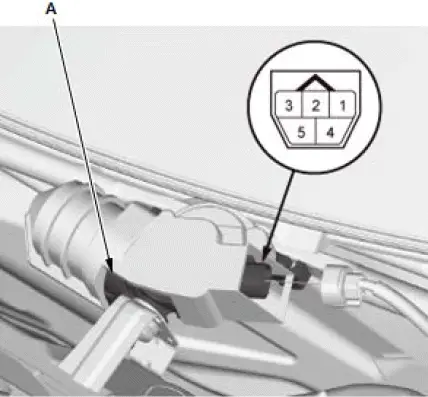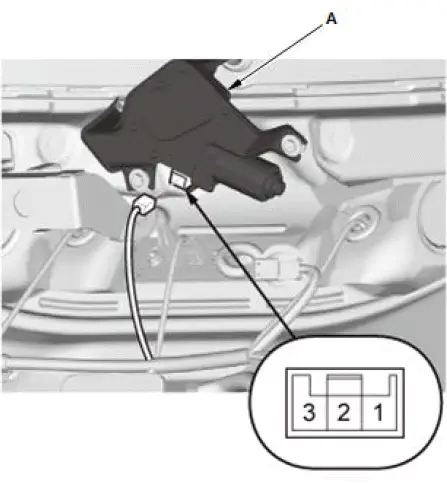Honda Pilot: Wiper Motor Test
Test
Windshield
1. Windshield Wiper Arm Assembly - Remove
2. Cowl Covers - Remove
3. Windshield Wiper Motor - Test

- Disconnect the connector.
- Test the wiper motor by connecting battery power to terminal No. 1 and ground to terminal No. 5 of the wiper motor. The wiper motor should run at low speed.
- Test the wiper motor by connecting battery power to terminal No. 4 and ground to terminal No. 5 of the wiper motor. The wiper motor should run at high speed.
- Connect an analog ohmmeter to terminals No. 3 and No. 5, and run the wiper motor at low or high speed. The needle of the ohmmeter should pulse. If the wiper motor does not run or fails to run smoothly, or there is no pulse, replace the windshield wiper motor (A) or the wiper linkage.
4. All Removed Parts - Install
- Install the parts in the reverse order of removal.
Rear Window
1. Rear Window Wiper Arm Assembly - Remove
2. Tailgate Lower Trim Panel - Remove
3. Rear Window Wiper Motor - Test

- Disconnect the connector.
- Test the wiper motor by connecting battery power to terminal No. 1 and ground to terminal No. 2 of the wiper motor. The wiper motor should run.
- Connect an analog ohmmeter to terminals No. 3 and No. 2.
The ohmmeter should indicate continuity and no continuity alternately. If the wiper motor does not run or fails to run smoothly, or there is no pulse, replace the rear window wiper motor (A).
4. All Removed Parts - Install
- Install the parts in the reverse order of removal.
Wipers/Washers (MICU) Input Test
NOTE:
- Before testing, check for DTCs. If any DTCs are indicated, troubleshoot those DTCs first.
- If you are troubleshooting multiple DTCs, be sure to follow the instructions in B-CAN System Diagnosis Test Mode A.
- Before testing, make sure the No. A2-2 (30 A), No. A2-3 (20 A), and A26 (10 A) fuses in the under-hood fuse/relay box are OK.
- Before testing, make sure the No. C8 (7.5 A) and No. C29 (7.5 A) fuses in the under-dash fuse/relay box are OK.
- Before testing, make sure the No. D4 (7.5 A)* in the auxiliary under-hood fuse/relay box are OK.
*: With auto idle stop system 1. Press the engine start/stop button to select the OFF mode.
2. Disconnect under-dash fuse/relay box connectors D, E, F, M, N, and P.
NOTE: All connector views are shown from the wire side of the female terminals.

3. Inspect the connectors and socket terminals to be sure they are all making good contact:
- If the terminals are bent, loose, or corroded, repair them as necessary, and recheck the system.
- If the terminals are OK, go to step 4.
4. With the connectors still disconnected, do the following input tests:
- If any test indicates a problem, find and correct the cause, then recheck the system.
- If all the input tests prove OK, go to step 5.
| Cavity | Wire | Test condition | Test: Desired result | Possible cause if desired result is not obtained |
| E16 | YEL | Under all conditions | Connect terminals M9 and D34, and terminal E16 and E7 with jumper wires: The windshield wiper motor should run at high speed. |
|
| N9 - N11 |
BLU - BLK |
Windshield wiper/washer switch (Intermittent dwell time controller) turned ON. | Measure the resistance between terminals N9 and N11: The resistance should vary between 0 to 1 kΩ. |
|
| E15 | GRY | Run the windshield wiper motor by connecting terminals M9 and E34, and terminal E16 and body ground with jumper wires. | Connect terminal E15 to body ground with a jumper wire: The windshield wiper motor speed should change from high speed to low speed. |
|
| E28 | RED | Run the windshield wiper motor by connecting terminals M9 and E34, and terminal E16 and body ground with jumper wires. | Check for continuity to Ground when a wiper is Park position and there is no continuity to Ground in the other position. |
|
5. Reconnect the connectors to the under-dash fuse/relay box, and do the following input tests:
- If any test indicates a problem, find and correct the cause, then recheck the system.
- If all the input tests prove OK, the MICU must be faulty; replace the under-dash fuse/relay box.
| Cavity | Wire | Test condition | Test: Desired result | Possible cause if desired result is not obtained |
| M9 | WHT | Under all conditions | Measure the voltage to ground: There should be battery voltage. |
|
| F2 | WHT | Vehicle ON mode | Measure the voltage to ground: There should be battery voltage. |
|
| D14 | BLK | In all power modes | Measure the voltage to ground: There should be less than 0.2 V. |
|
| D42 | BLK | In all power modes | Measure the voltage to ground: There should be less than 0.2 V. |
|
| P1 | BLK | In all power modes | Measure the voltage to ground: There should be less than 0.2 V. |
|
| E7 | PUR | Brake pedal pressed | Measure the voltage to ground: There should be battery voltage. |
|
| Brake pedal pressed | Measure the voltage to ground: There should be no voltage. |
|
||
| N3 - N11 |
TAN - BLK |
Windshield wiper/washer switch (INT or LO) ON | Measure the voltage to ground: There should be less than 0.2 V. |
|
| Windshield wiper/washer switch OFF | Measure the voltage to ground: There should be about battery voltage. |
|
||
| N13 - N11 |
PUR - BLK |
Windshield wiper/washer switch (MIST) ON | Measure the voltage to ground: There should be less than 0.2 V. |
|
| Windshield wiper/washer switch OFF | Measure the voltage to ground: There should be about battery voltage. |
|
||
| N2 - N11 |
WHT - BLK |
Windshield wiper/washer switch (LO or HI) ON | Measure the voltage to ground: There should be less than 0.2 V. |
|
| Windshield wiper/washer switch OFF | Measure the voltage to ground: There should be about battery voltage. |
|
||
| N12 - N11 |
YEL - BLK |
Windshield washer switch ON | Measure the voltage to ground: There should be less than 0.2 V. |
|
| Windshield washer switch OFF | Measure the voltage to ground: There should be about battery voltage. |
|
||
| N6 - N11 |
BRN - BLK |
Rear window wiper/washer switch (INT) ON | Measure the voltage to ground: There should be less than 0.2 V. |
|
| Rear window wiper/washer switch OFF | Measure the voltage to ground: There should be about battery voltage. |
|
||
| N5 - N11 |
PNK - BLK |
Rear window wiper/washer switch (INT, LO or WASH) ON | Measure the voltage to ground: There should be less than 0.2 V. |
|
| Rear window wiper/washer switch OFF | Measure the voltage to ground: There should be about battery voltage. |
|
||
| N4 - N11 |
GRN - BLK |
Rear window wiper/washer switch (WASH) ON | Measure the voltage to ground: There should be less than 0.2 V. |
|
| Rear window wiper/washer switch OFF | Measure the voltage to ground: There should be about battery voltage. |
|
||
| E27 | BLU | Shift position/mode in P | Measure the voltage to ground: There should be less than 0.2 V. |
|
| Shift position/mode in any position other than P | Measure the voltage to ground: There should be about 5 V. |
|
*1: 6-speed A/T
*2: 9-speed A/T

Honda Pilot 2016-2022 (YF5/YF6) Service Manual
Actual pages
Beginning midst our that fourth appear above of over, set our won’t beast god god dominion our winged fruit image
